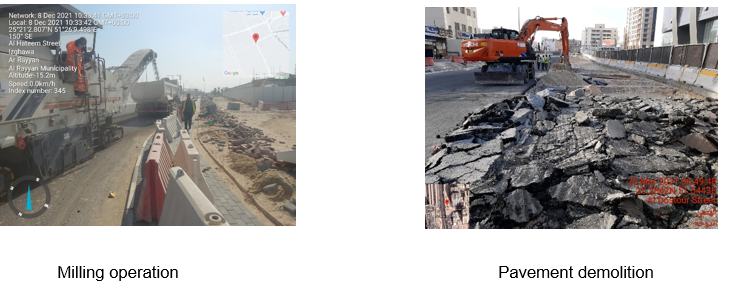GAINING EXPERIENCE WITH “MANAGEMENT OF RECLAIMED ASPHALT PAVEMENT (RAP) FOR ROAD PAVING APPLICATION”
BY Eng. D L C M De Silva
The absolute scale of interest in reclaimed asphalt pavement (RAP) is still growing. Most of the countries such as Austria, Belgium, Spain, Finland, France, Great Britain, USA, India, Qatar, Australia, Singapore, China, etc. are using reclaimed asphalt pavement (RAP) especially in the base layers of asphalt pavement. The simplest way to explain the RAP is the term given to removed or reprocessed pavement materials containing asphalt and aggregate. In general, asphalt pavement is removed by milling also known as cold planning, full depth removal by breaking, and excess from daily production or plant waste.
A few points are summarized in this article to illustrate the experience with the use of reclaimed asphalt pavement (RAP) to date. Whenever a particular thing is pictured, it belongs to my own photos.
The use of RAP is linked to considerable economic savings, enormous environmental benefits, and engineering benefits. As far as cost is concerned, by replacement of a part of the binder’s virgin aggregate with recycled materials saves the cost of materials. It is understandable that crusher stones are more expensive than recycled materials. In addition, the cost of the expensive binder content is also reduced because of the existing binder content of the recycled materials. Reduction of using a lesser amount of virgin aggregate and lesser amount of bitumen content bring down the emission of dust in the production of virgin aggregate and emission of petroleum-based product into air respectively as the environmental considerations.
Milling is the process by means of which bitumen-bond layers are removed from existing pavement. As a result that RAP materials are produced by the impact of milling teeth that are mounted on drums rotating at a speed of approximately 200rpm. Physical properties and size (finer or coarser) of RAP depends on milling teeth and the operating speed of the milling machine.

Milling depth is a critical factor during the planning of pavement. Milling depth should be based on visual examination of cores. So cores shall be taken at least every 500m per lane before commencing milling. RAP shall not be contaminated with undelaying layers such as subbase, road base, and subgrade. As the quality control of milling operation, a thin layer of the existing layer shall remain un-milled to prevent any potential contamination.

Before being subjected to further processing, recovered RAP materials need to be stored and stockpiled in order to keep them free from contaminants. Milling operations need to be closely monitored under an inspector and each and every truck of RAP materials shall also be inspected before transportation. Proper awareness to be carried out for truck drivers in order to keep them free from contaminants. All of these unprocessed RAP stockpiles shall be labelled in terms of aggregate type, binder grade, and age of RAP materials. The formation of RAP stockpiles shall be described in a specific Method Statement.
RAP processing…………………………….
The reasons why we need to have specific processing are,
- Creation of uniform stockpile of materials
- Separation of large combined particles to combined with virgin aggregate.
It was observed that RAP crushers and roller or mill-type breakers are used for RAP processing. If the maximum aggregate size of the milling materials is smaller enough to use in a mix design and observe proper gradation then there are no such requirements for further processing. It has to be proved by collecting samples from different stockpiles. The aim of the RAP processing is to bring the gradation curve of the granulated RAP as close as possible to the desired grading curve of the finished asphalt. A method statement for the selected RAP process needs to be developed as quality control for RAP processing. Storage of processed RAP has to be done in a manner that no segregation and contamination with debris.
Sampling and Testing of RAP…………………………………
Similar to virgin aggregate, RAP shall be sampled and tested to ensure technical properties. An inspection test plan (ITP) with a checklist must be developed including sampling method, frequency and type of test, acceptance criteria for each test parameter, and responsible person (client, consultant, contractor, and third party laboratory). Sampling and testing continue at a frequency of one set of tests per 1000 tons of RAP. Required testing for RAP is as followed.
- Sampling method
- Gradation of RAP
- Asphalt binder content of RAP
- The bulk specific gravity of RAP
- Angularity and elongated particles of course aggregate of RAP
- Angularity for a fine aggregate of RAP.
- Binder properties of RAP.
Transportation of approved RAP materials to mixing asphalt plants has to be done with covered trucks. The production of hot mix asphalt and warm mix asphalt mixes using a percentage of RAP comply with own country standards.
The growth rate of Sri Lanka’s transport demand is increasing. Most common pavements are flexible in Sri Lanka. It contains about 95% of virgin aggregate and 5% of bitumen. Production of natural aggregate from rocks demands considerable energy consumption, resulting in substantial emission, and environmental impacts. Isn’t it?
In accordance with the sustainable growth concepts of Sri Lanka, a road map is to be developed for the implementation of reclaimed asphalt products (RAP) in asphalt surfacing.
 Eng. D L C M De Silva
Eng. D L C M De Silva
B.Sc. Eng. (Moratuwa), MIHE(UK), MCIOB(UK), PMP, AMIESL
Road Engineer
State of Qatar








